Statistics/pl: Difference between revisions
From LimeSurvey Manual
Maren.fritz (talk | contribs) (Created page with "<div class="simplebox">File:help.png Należy pamiętać, że LimeSurvey nie może tworzyć wykresów z niektórych typów pytań. Na przykład Typ pytania - Typ pytania...") |
Maren.fritz (talk | contribs) (Created page with "Aby zobaczyć, które pytania mogą wykorzystywać statystyki i/lub wykresy, przeczytaj ręczny wpis dotyczący każdego typu pytania tutaj. Jeśli dostępna j...") |
||
| Line 160: | Line 160: | ||
Aby zobaczyć, które pytania mogą wykorzystywać statystyki i/lub wykresy, przeczytaj ręczny wpis dotyczący każdego typu pytania [[Typy pytań|tutaj]]. Jeśli dostępna jest zakładka Statystyki, sprawdź, jakie opcje wyświetlają się pod tą zakładką. Istnieją trzy atrybuty statystyki: [[QS:Typ wykresu|typ wykresu]], [[QS:Wyświetl wykres|wyświetl wykres]] i [[QS:Statystyki publiczne|statystyki publiczne]].</div> | |||
=="Incomplete responses", "no answers" and "not completed/not displayed" count== | =="Incomplete responses", "no answers" and "not completed/not displayed" count== | ||
Revision as of 09:17, 26 September 2023
Ogólne
Celem ankiety jest „uzyskanie odpowiedzi na pytania”. Po utworzeniu, aktywowaniu i zaproszeniu uczestników do wypełnienia ankiety możesz skorzystać z funkcji „Odpowiedzi i statystyki” w celu gromadzenia i analizowania wyników ankiety w celu uzyskania odpowiedzi.
Funkcja statystyk znajduje się w menu odpowiedzi aktywnej ankiety: Odpowiedzi' > Odpowiedzi i statystyki Odpowiedzi jest dostępne tylko wtedy, gdy ankieta została aktywowana.

Kliknij opcję „Statystyki” znajdującą się na górnym pasku narzędzi.

Wyświetli się następująca strona.

Statystyki LimeSurvey mogą być wyświetlane w „trybie eksperckim” lub „trybie prostym”. Domyślnie po kliknięciu Statystyki wyświetlany jest „tryb eksperta”
Statystyki - tryb eksperta
Twoja ankieta została zakończona i chcesz teraz rozpocząć analizę wyników. LimeSurvey może wyeksportować wszystkie wyniki do arkusza kalkulacyjnego Excel lub pliku CSV.
Funkcja statystyki – tryb ekspercki umożliwia „filtrowanie” danych oraz pobieranie liczb i podsumowań różnych pól. Skrypt statystyczny nie wykonuje bardzo skomplikowanego filtrowania, ale zawiera wiele bardzo przydatnych informacji, które można łatwo uzyskać.
Uruchamianie szybkich statystyk
Na poniższym zrzucie ekranu widać, że przy każdym pytaniu znajduje się pole wyboru, które można zaznaczyć, aby wyświetlić podsumowanie odpowiedzi na każde pytanie oraz ikonę, która po kliknięciu (lub najechaniu na nią myszką) wyświetla pełny tekst pytania. Aby wyświetlić wyniki dla pytania lub pytań, zaznacz pola wyboru u góry pytania (pytań), a następnie kliknij „Wyświetl statystyki”.
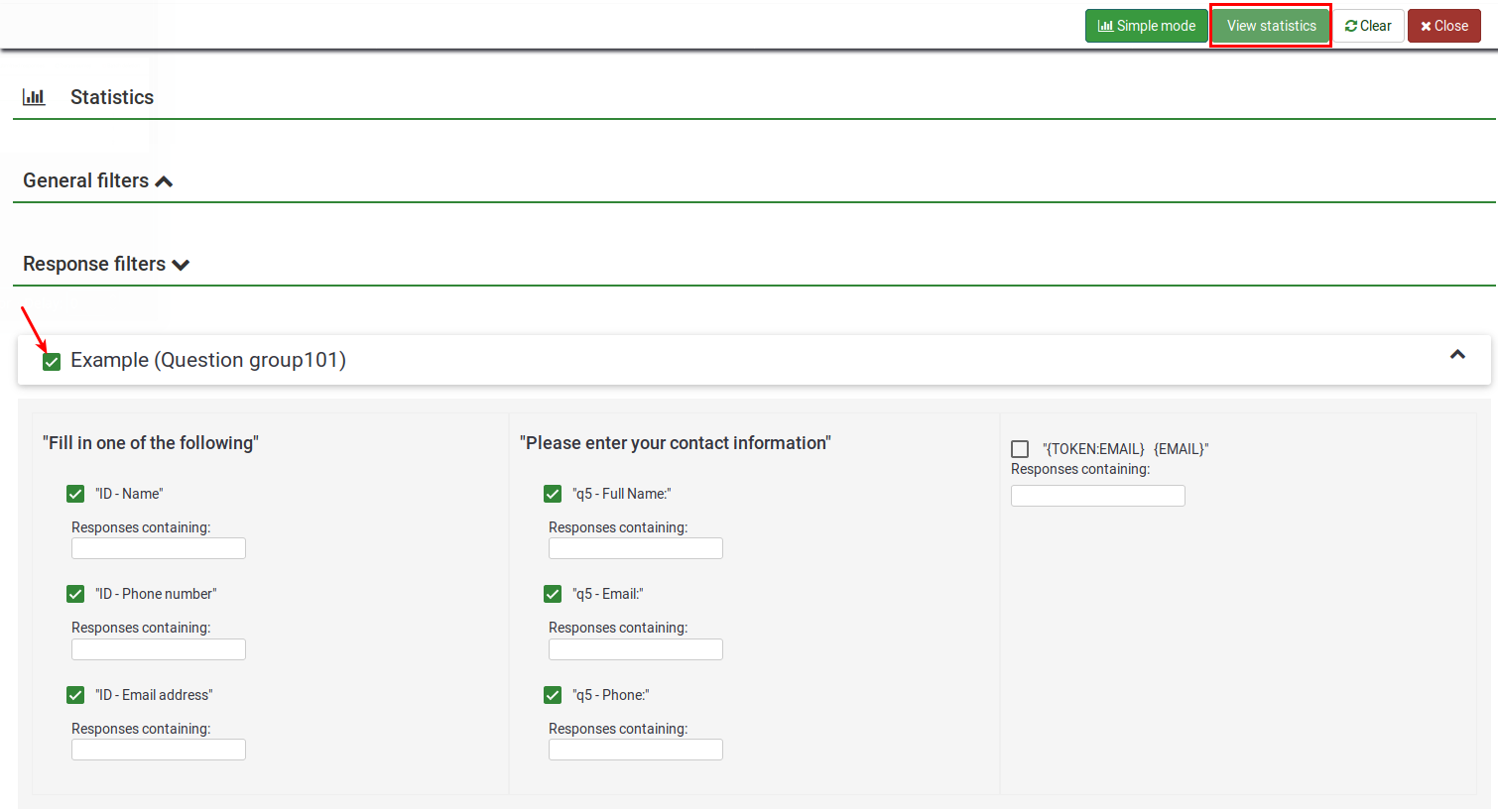
Alternatywnie, aby zobaczyć wyniki dla wszystkich dostępnych pytań, włącz opcję „Wyświetl podsumowanie wszystkich dostępnych pól”, a następnie kliknij „Wyświetl statystyki”.
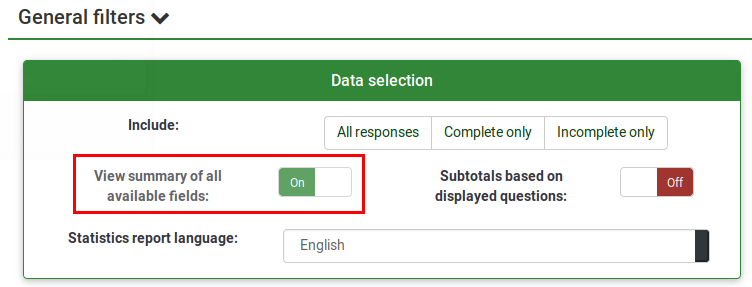
Następnie otrzymasz tabelę „Wyniki”, która będzie wskazywała liczbę przypadków oraz tabelę „Podsumowanie pola” dla każdego wybranego pytania, która podsumowuje wszystkie możliwe odpowiedzi na pytania (pytania), ich sumy i odpowiadające im odpowiedzi. odsetek.
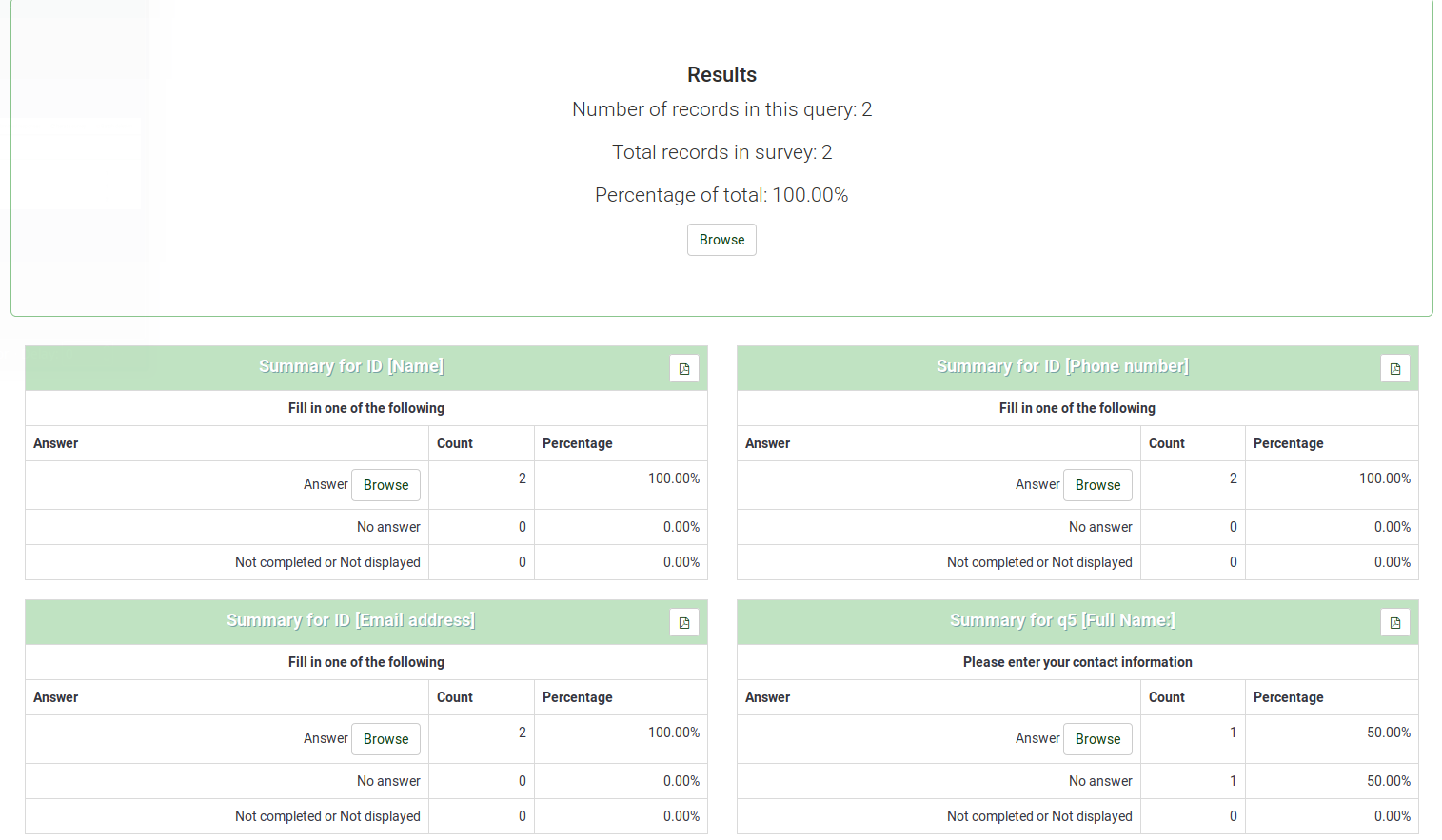
Filtrowanie danych
Istnieją dwa typy filtrów: ogólne i filtry odpowiedzi.
Filtry ogólne
Jak sama nazwa wskazuje, „Filtry ogólne” odnoszą się do filtrów na poziomie ogólnym (makro).
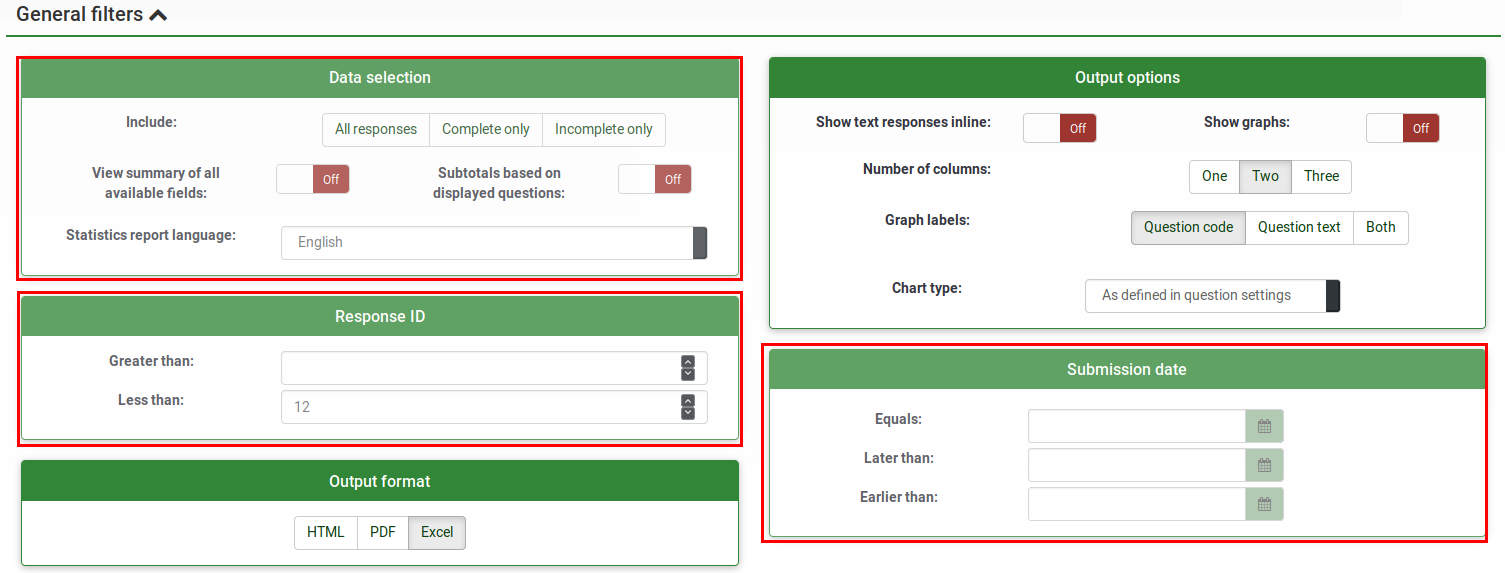
Filtry mogą być powiązane z:
- Wybór danych
- Typ odpowiedzi:
- Odpowiedzi pełne: odpowiedzi zawierające datę przesłania
- Odpowiedzi niepełne: odpowiedzi, które nie nie zawiera daty przesłania
- Wszystkie rekordy: zagregowana liczba odpowiedzi pełnych i niekompletnych.
- Język raportów statystycznych: jeśli używane są dodatkowe języki, ta opcja filtrowania jest przydatna do podziału uczestników na podstawie języka, jakiego użyli do wypełnienia ankiety.
- Typ odpowiedzi:
- Wyświetl podsumowanie wszystkich dostępnych pól: Domyślnie wyłączone. Po włączeniu tej opcji wszystkie pytania i grupy ankiety zostaną uwzględnione podczas uruchamiania skryptu statystycznego
- Podsumowania na podstawie wyświetlonych pytań: Domyślnie wyłączone. Zlicza statystyki dla każdego pytania na podstawie całkowitej liczby odpowiedzi, dla których wyświetliło się pytanie (dobry sposób na filtrowanie niedokończonych/niekompletnych odpowiedzi).
- Identyfikator odpowiedzi: Użyj numeru identyfikacyjnego, aby filtrować zebrane odpowiedzi
- Data przesłania:Wyświetlana tylko wtedy, gdy włączona jest opcja timingi. Możesz filtrować dane na podstawie daty przesłania zebranych odpowiedzi.
Aby odpowiedzi zostały przefiltrowane wyłącznie według filtrów ogólnych, włącz opcję "Wyświetl podsumowanie wszystkich dostępnych pól" i kliknij przycisk "Wyświetl statystyki" znajdujący się w prawej górnej części ekran.
Filtry odpowiedzi
W zależności od użytego typ pytania, do filtrowania odpowiedzi mogą zostać użyte różne pola:
- Według odpowiedzi: Kliknij jedną lub więcej odpowiedzi na liście pod każdym pytaniem, aby przefiltrować dane według tych odpowiedzi (użyj klawisza CTRL/kliknij, aby wybrać wiele odpowiedzi w tym samym pytaniu). Pamiętaj, że jeśli zdecydujesz się wyświetlić podsumowanie wszystkich dostępnych pól (pole wyboru u góry), przed zaznaczeniem tego pola konieczne będzie wybranie filtrów odpowiedzi.
- Według tekstu:Możesz wyszukiwać odpowiedzi na pytania typu tekstowego (i podobnych typów), wpisując tekst. Jeśli chcesz wyszukać częściowy ciąg, możesz użyć znaku procentu (%) jako symbolu wieloznacznego. Np.: jeśli szukasz „Tom%”, znajdziesz wpisy z „Tomb” i „Tommy” itp.
- Według wartości liczbowej: Możesz wyszukiwać odpowiedzi zawierające określoną wartość liczbową, jeśli używane są pytania oparte na liczbach.
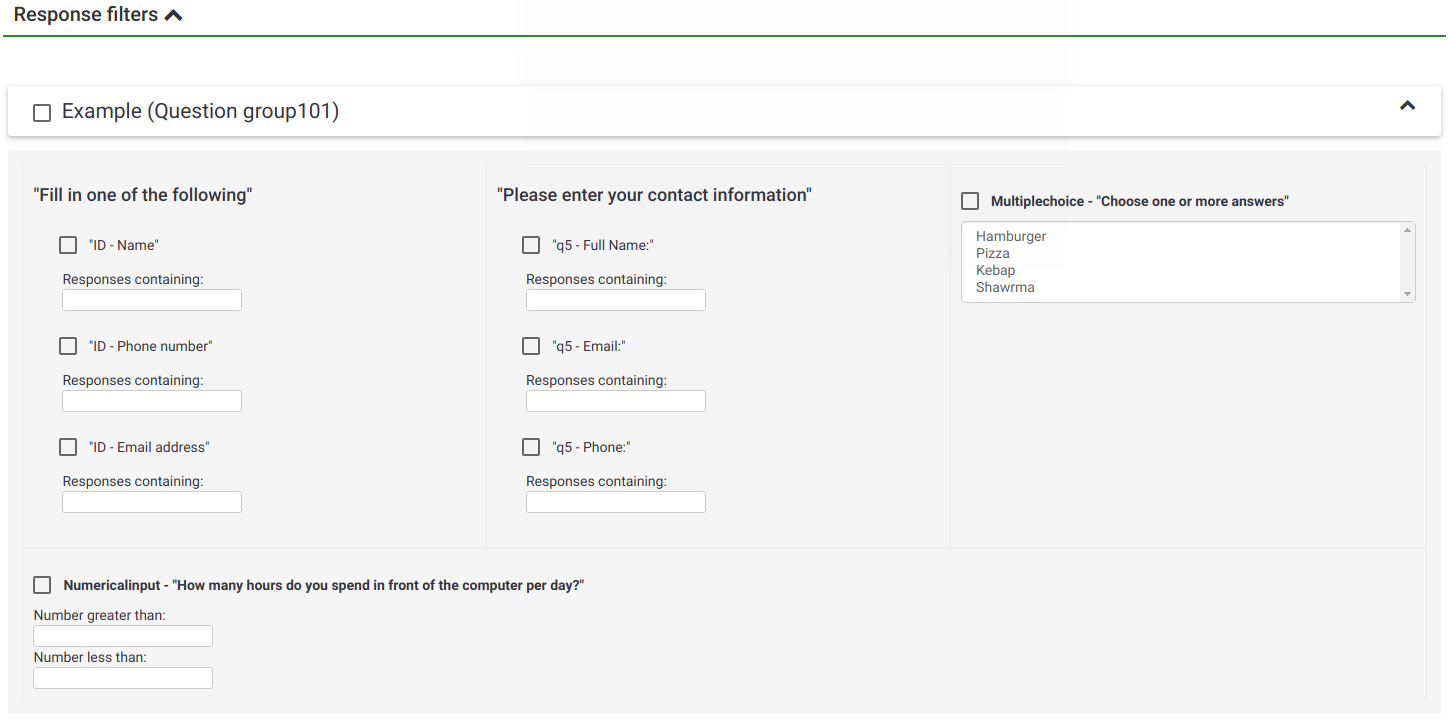
Wybranie opcji „Wyświetl statystyki” spowoduje wyświetlenie tabeli „Wyniki”, wskazującej liczbę odpowiedzi spełniających Twoje kryteria, oraz tabeli „Podsumowanie pola” dla każdego wybranego pytania, która podsumowuje wszystkie możliwe odpowiedzi w pytań, ich sumę i procent. Należy pamiętać, że wyniki te stanowią podzbiór całkowitej liczby odpowiedzi. Na przykład, jeśli kryteria wyświetlają 146 rekordów z łącznej liczby 180, podsumowanie pokaże podział tylko tych 146 rekordów dla tej tabeli.
Poniższe obrazy wskazują, że użytkownik wybrał przeglądanie statystyk dla „Statusu zatrudnienia” „ukończonych danych/kobiet/wiek 18–25 lat” „”. Daje to wyniki dla 6 z 13 rekordów.
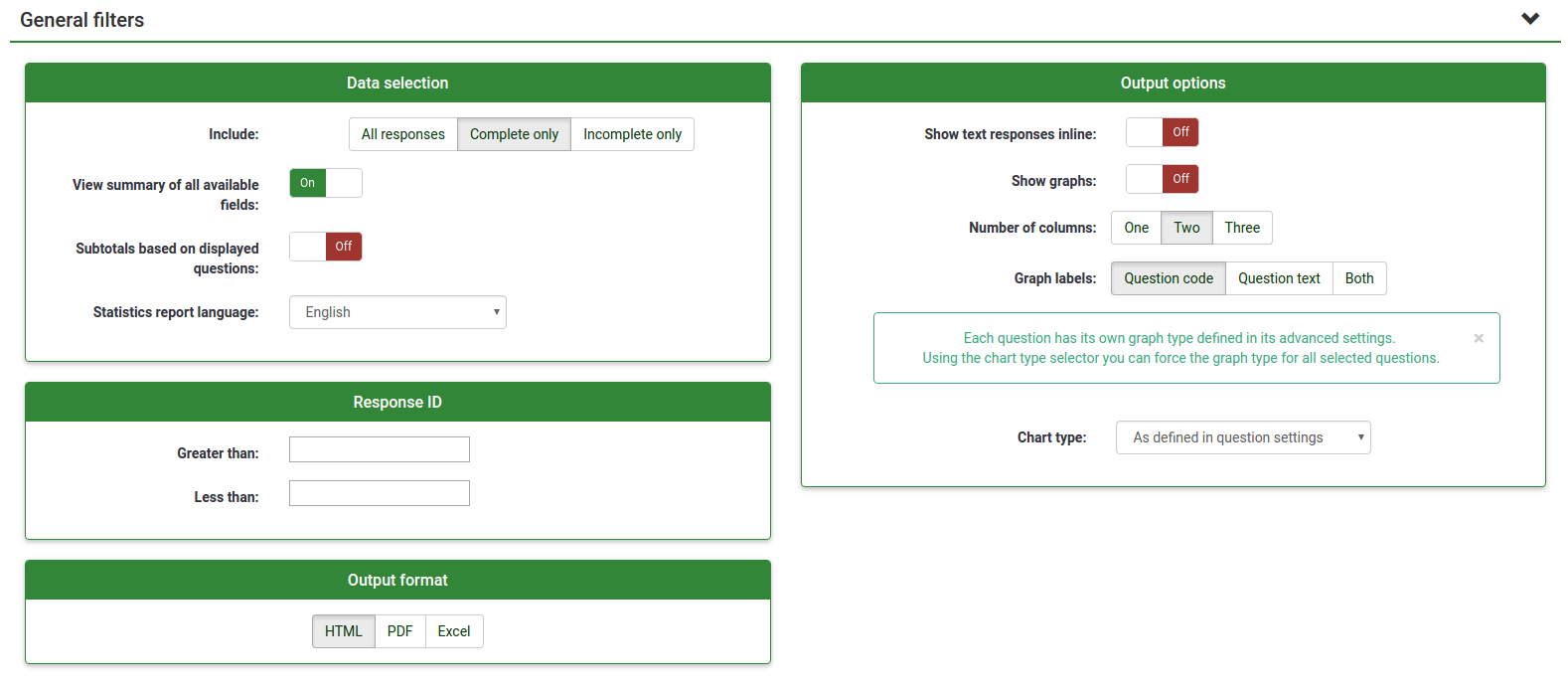

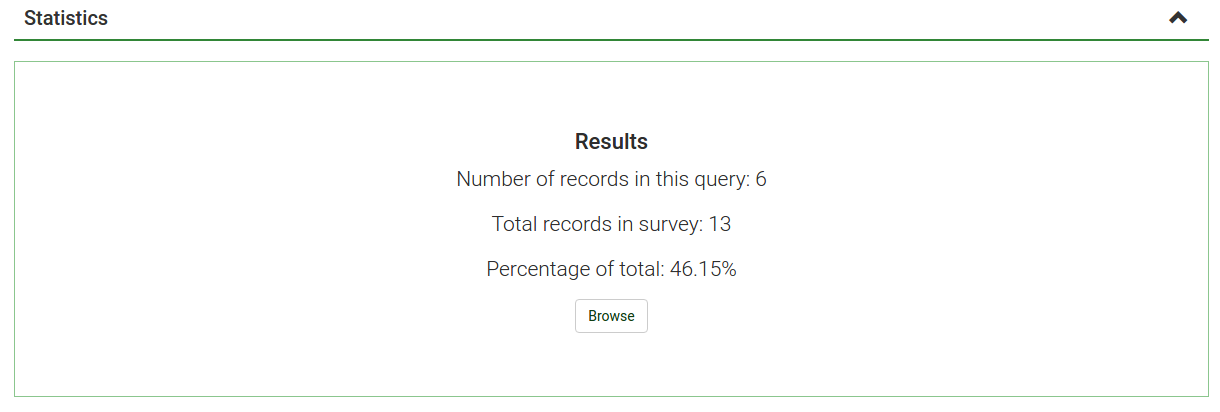
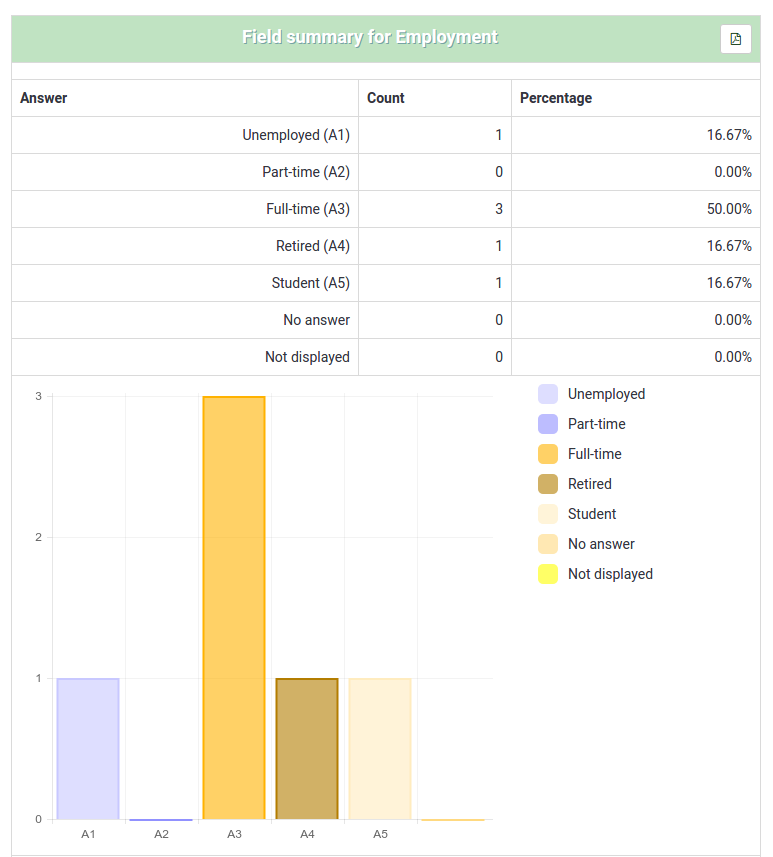
- Jeśli ustawisz kryteria dla tego samego pytania, które chcesz podsumować, wówczas w tym pytaniu zostaną wyświetlone tylko odpowiedzi spełniające Twoje kryteria. Zatem dobrą praktyką jest „nie” ustawianie jakichkolwiek kryteriów dla tego samego pytania, którego podsumowanie jest wyświetlane.
- Aby wybrać wiele wpisów dla jednego pytania, przytrzymaj przycisk CTRL podczas klikania. Aby „odznaczyć” ostatnie kryteria (jeśli chcesz usunąć wszystkie kryteria z pytania) kliknij odpowiednią podświetloną odpowiedź, trzymając wciśnięty przycisk CTRL.
Wykresy
Do tworzenia wykresów używana jest biblioteka pChart, która jest całkowicie dołączona i zwykle nie wymaga konfiguracji.
Po wygenerowaniu wykresów można je łatwo wyeksportować. Kliknij wykres prawym przyciskiem myszy i wybierz „Zapisz obraz jako”, a następnie zapisz wykres jako plik .png w wybranej lokalizacji.
Możesz także użyć funkcji „Eksportuj obrazy”, aby zapisać wszystkie wykresy.
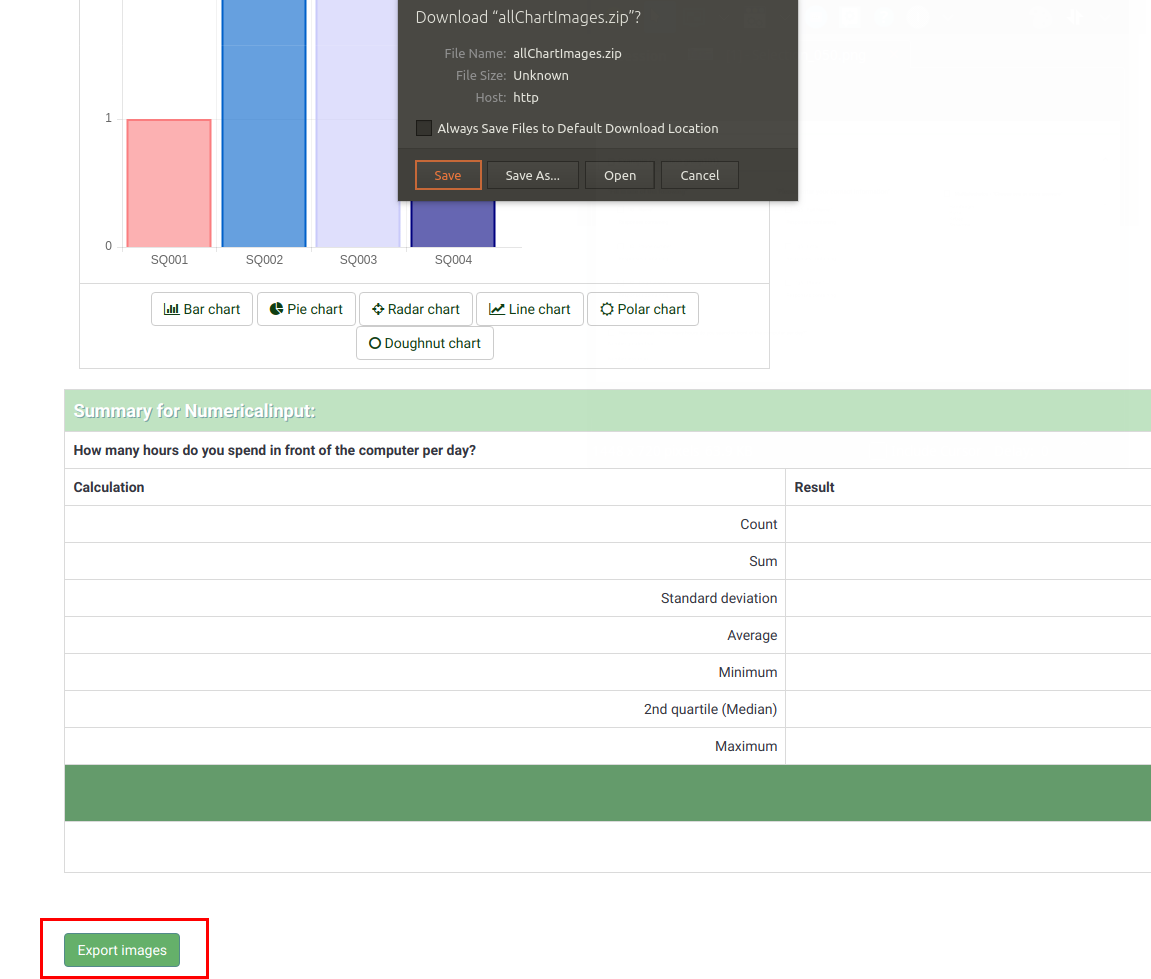
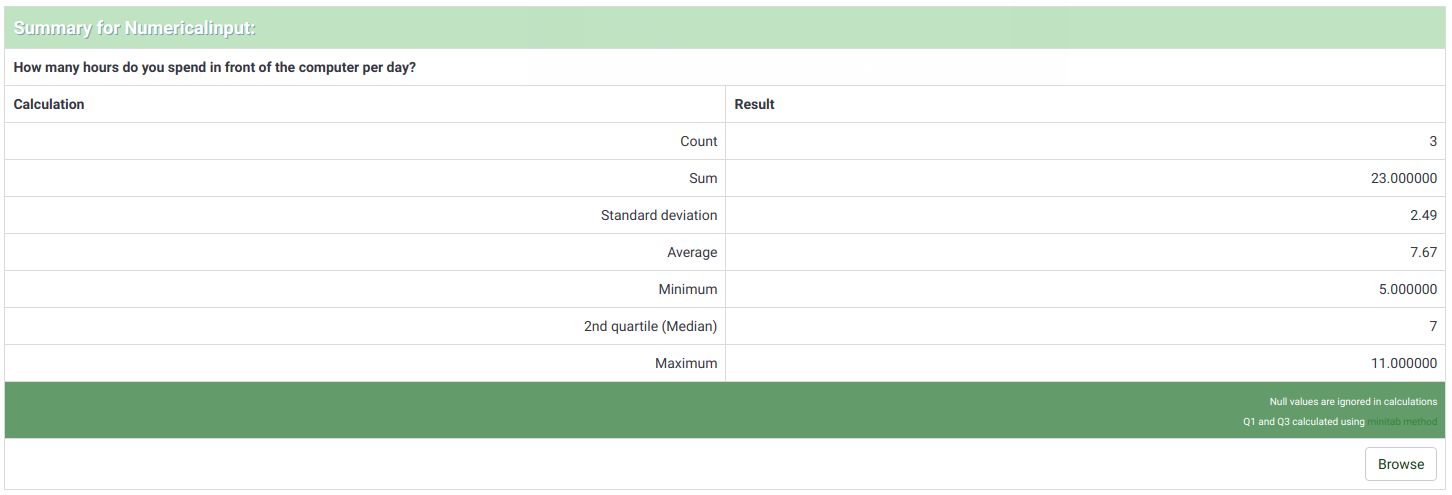
"Incomplete responses", "no answers" and "not completed/not displayed" count
- incomplete responses: All questions started but not completed - the participant clicked the "Next" button in the survey, but did not click the "Submit" button (did not land on the end page of your survey).
There is no SubmitDate in the response table for this entry, but new data set was created already.
- no answer: The question was displayed, but the participant did not an answer.
The question is not mandatory, was displayed, received no answer and the user clicked "Next" or "Submit". The consequence is that the database field for this answer is set to "" (empty string). This "no answer" status cannot be really computed for "Date" or pure "Numerical questions" where the database field cannot record a string.
- not completed/not displayed: The page containing the question was not displayed. This can be because of conditions, or because the participant left the survey before this page was displayed (or while this page is displayed, but without clicking the Next button).
The database field for this question is filled with a NULL value.
Output format and options
The statistics can be displayed in three different formats:
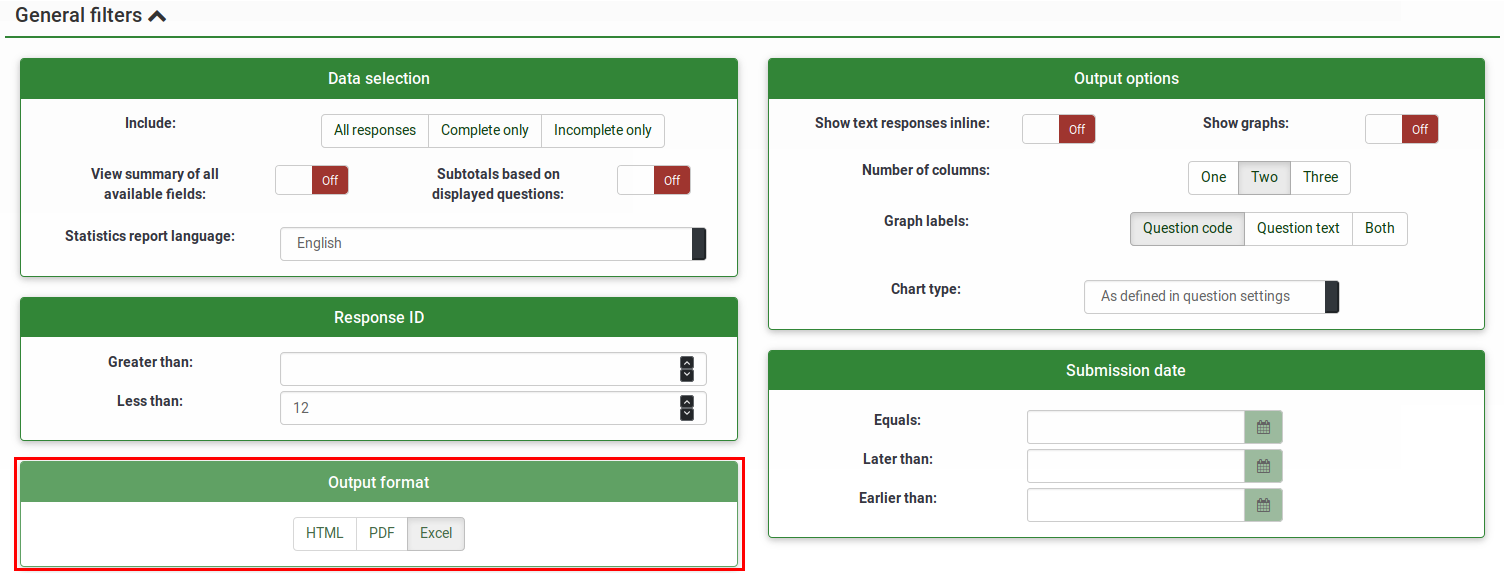
- HTML (default option): The statistics are displayed in LimeSurvey.
- PDF: A popup will be displayed, asking to save the statistics as a PDF file.
- Excel: To further work with your (filtered) data, choose Excel. You can export the file from a spreadsheet application to CSV to work with more advanced statistical tools such as SPSS or R.
The output options can be used to alter the way the statistics are displayed. The following options are available:
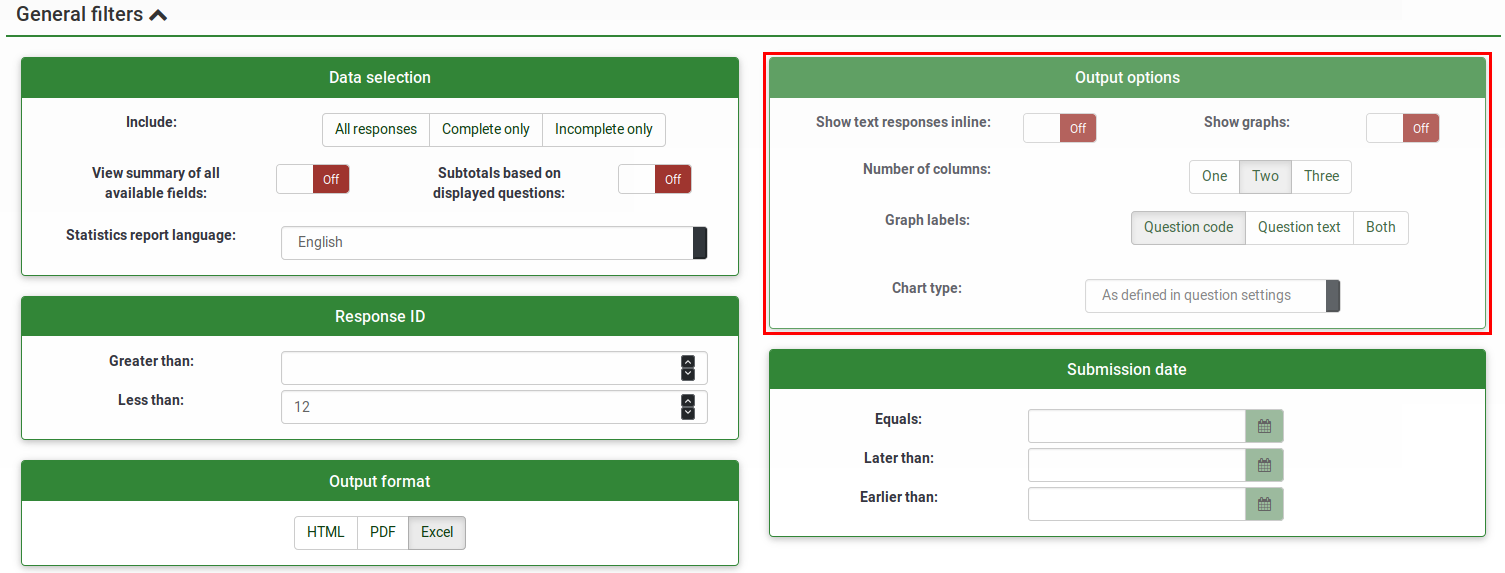
- Show text responses inline: Disabled by default. Shows the text questions responses without having to click a browse button (if enabled; useful for the HTML version of output format)
- Show graphs: Disabled by default. If enabled, graphs will be displayed.
- Number of columns: Two is the default number. If you wish to have statistics and graphs displayed on only one or three columns, choose the desired value from this option. It applies to HTML statistics.
- Graph labels: Choose how the label should look in the graph.
- Question code
- Question text
- Both
- Chart type: the following chart type settings are available:
- As defined in question settings: Useful if you do not want the graph to be displayed. If this is the case, deactivate it from the question settings and select from the "Statistics" panel this option.
- Bar chart
- Pie chart
- Radar chart
- Line chart
- Polar chart
- Doughnut chart
Embed custom logo at statistic PDF
If you want to embed your own logo to the statistics PDF, make sure a file specifically named "statistics.jpg" is placed within the "images" folder of the admin theme used for your system. The admin theme that you would like to use can be set in Global Settings.
Statistics - simple mode
The simple mode was created to provide simple bar chart statistics that can be quickly exported and saved, and then included into a presentation:
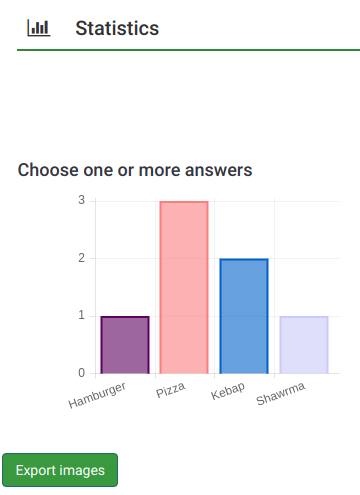
Fewer graphs are displayed than in the expert mode. While in the export mode you can display graphs with respect to those who filled out the survey, did not answer it or did not complete it. the simple mode displays only statistics that rely on the "countable" data submitted by the participants (e.g., single or multiple choice questions as well as array questions).
There is only one option to filter the data within the simple mode - via the responses to be included in the statistics. As a result, the statistics may include the complete responses, incomplete responses, or all responses (the aggregated sum of the first two options). This option is located in the upper-right part of the panel.
To switch back to expert mode, click the "Expert mode" button located in the upper-right part of the screen:

Public statistics
LimeSurvey includes the functionality to display simple statistics to the general public or to your participants after they have completed an online survey.
Two components need to be enabled to activate and display statistics to your participants. The first one refers to the public statistics of your survey which must be enabled (it is turned off by default). It is located under the Presentation tab. To also show graphs, look on the same page for the Show graphs in public statistics attribute and enable it (it is disabled by default).
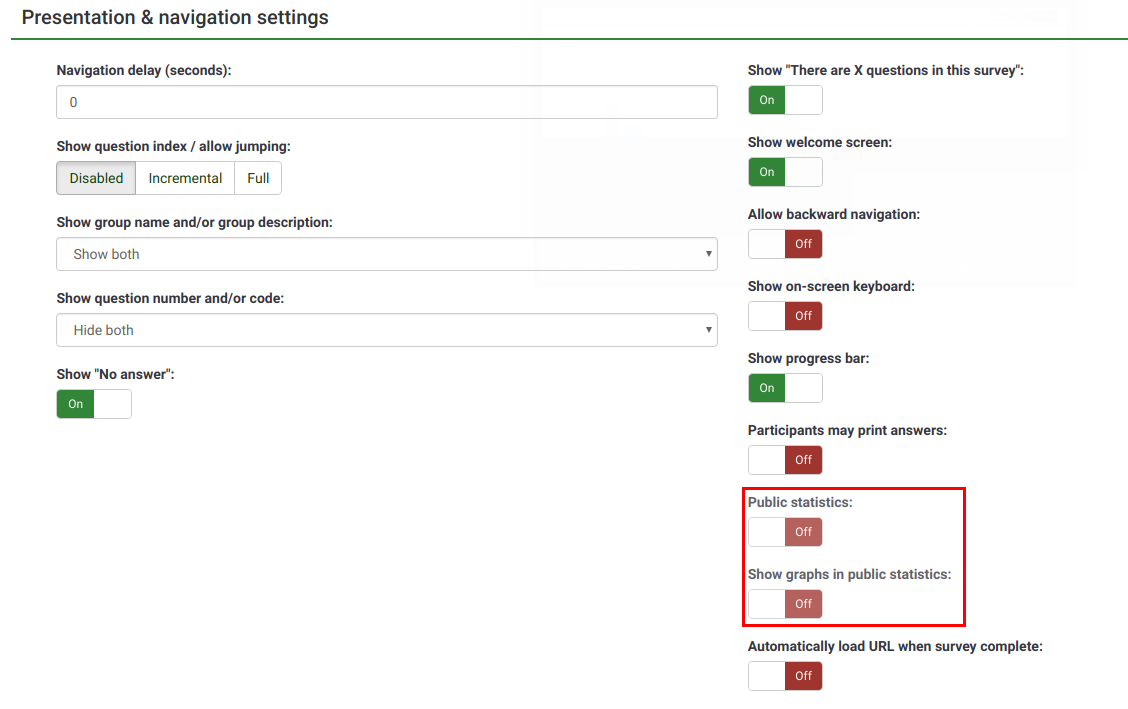
Once you have set your survey to display statistics, you need to indicate question-by-question which statistics you want to be displayed to your respondents. By default, no questions will be displayed. To have them displayed, access the desired question, look for the "Statistics" tab and enable the Show in public statistics attribute.
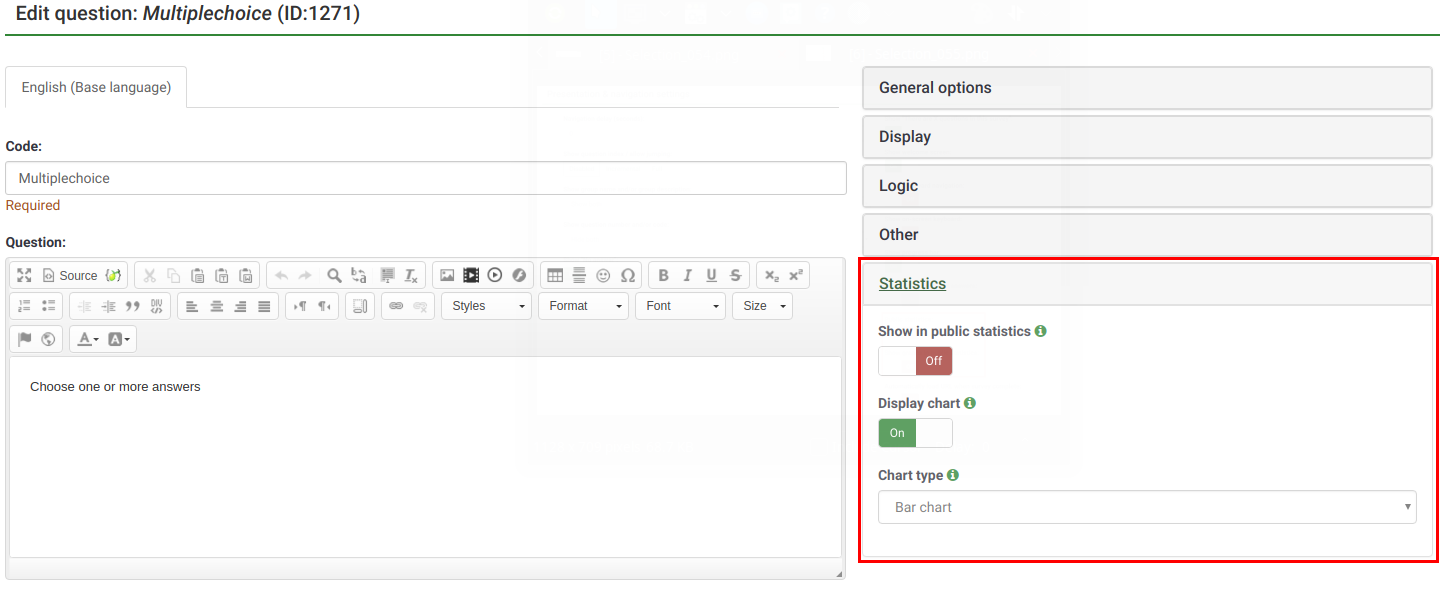
What participants see
Once you have enabled public statistics and selected some questions to display, an additional option will be visible to participants when they complete your survey. In addition to the usual thank you, there will be a link to "View the statistics for this survey":

The survey statistics will be displayed on this page. Graphs can also be displayed by enabling the Display chart question attribute:
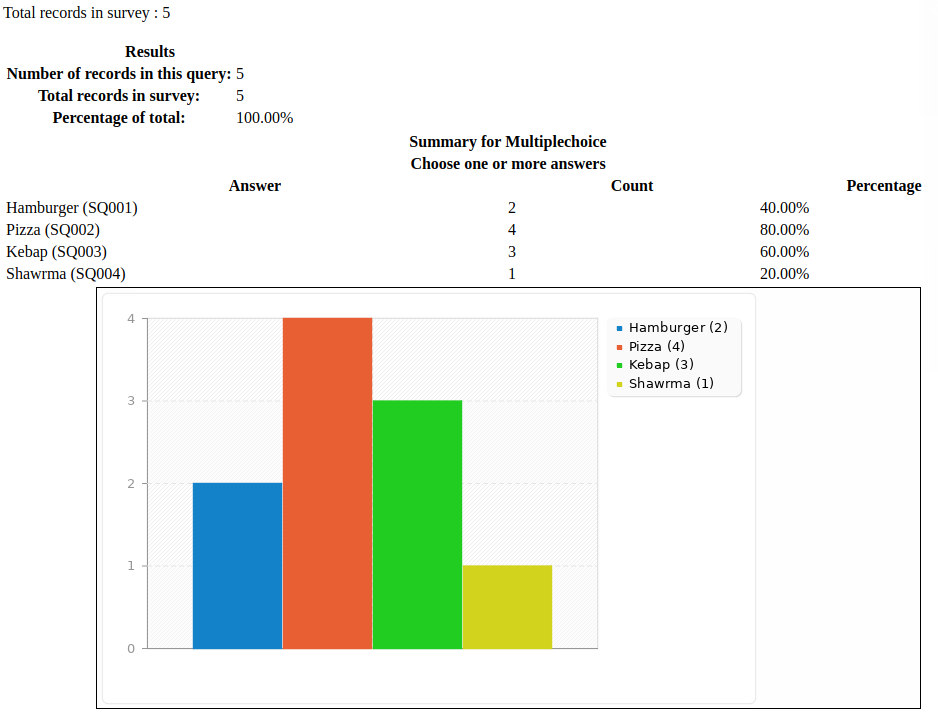
Changing the look of the public statistics page
The apprearance of the public statistics page can be modified via template.css (search for "#statsContainer"). However, there is currently no template on it's own that can be edited in the LimeSurvey theme editor.
Hints & tips
Feel free to edit the following wiki sections to let other LimeSurvey users learn about statistics-related hints & tips.
Wrong font when exporting statistics - what to do?
For some languages (like Chinese), the usual font used (Vera) does not cover the needed character set. In that case you can use the setting $chartfontfile to set a new TTF font file in config.php (Check out config-defaults.php for the right setting). For Chinese (Simplified and Traditional), another font has to be used such as the FireFlySung font which can be downloaded from github.
FAQs
5 Point choice question type - what do the values located under the "sum" column represent?
In the screenshot below, notice that the "Sum" column shows the aggregated values in the following way:
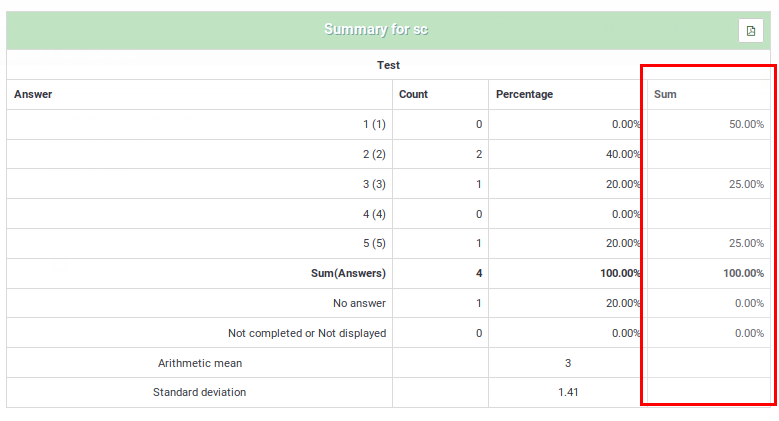
The grouping from the "Sum" column was done in this way because, when rating questions, survey administrators usually interpret the results in this way:
- Y percent of the participants DISLIKE item ABC, where Y represents the percentage of those who answered "1" and "2"
- X percent of the participants LIKE item ABC, where X represents the percentage of those who answered "4" and "5"
- Z percent of the participants have a NEUTRAL opinion about item ABC, where Z represents the percentage of those who answered "3"
| Answer | Count | Sum |
|---|---|---|
| 1 | 0 | 50% (the percentage of those who answered "1" and "2") |
| 2 | 2 | |
| 3 | 1 | 25% (the percentage of those who selected "3" - the neutral option) |
| 4 | 0 | |
| 5 | 1 | 25% (the sum of those who answered "4" and "5") |
| Sum (Answers) | 4 | 100% |
| No answer | 1 | 0% (always "0%") |
| Not completed or displayed | 0 | 0% (always "0%") |